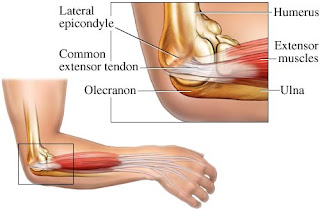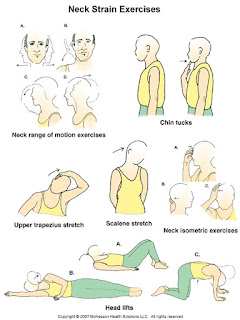When is tennis elbow not tennis elbow?

Tennis elbow is a real clinical entity otherwise known as lateral epicondylitis. It is a pathology which involves the tendons of the wrist extensors as they join the humerus up around the elbow. The true tennis elbow is characterised initially by inflammation of the tendon which then progresses onto ‘degeneration’ of the tendon. Most of these conditions that involve ‘white tissues’ such as tendons take a long long time to heal as the blood supply is poor and healing rates are notoriously slow. I am seeing two patients at the moment, one has had the problem 9 months and the other 3 months.
True tennis elbow tends to target not just tennis players but anyone who occupationally uses grip strength a lot. Typical occupations include carpenters, painters, mothers of new born children and weight lifters. The main long term treatment aim is the same as the other tendon degeneration injuries such as Achilles and patella tendons – eccentric loading of the tendon.
But not all lateral elbow pain is ‘tennis elbow’. Many conditions masquerade as tennis elbow and they typically fail to respond to conventional forms of treatment for tennis elbow.
1]‘pseudo tennis elbow’ involves the cervical spine and radial nerve in the arm. This condition typically targets occupational workers involved in lots of typing and mouse/computer work. basic cause s poor sitting posture.
2]The other type of ‘pseudo tennis elbow’ that we are now becoming more aware of seems to target male bodybuilders, weight lifters and gym goers. This type of lateral elbow pain commonly influences the joint just below the elbow known as the superior radioulnar joint. This is the pivot joint where the radial head joins the ulnar.
What happens in these conditions is the following sequence of events;
*)Frequent weight lifting movements done in positions of full pronation to partial pronation of the forearm. Only two exercises use the forearm in full supination, straight bar arm curls and underhand grip chin ups. Almost every other gym exercise is performed away from full supination, with many actually done in full pronation.
*)The pronator teres muscle (found on the medial side of the forearm but actually attaches to the anterior radius) gets overworked and becomes hypertonic (this does take months and months).
*)The lifter usually feels medial elbow pain initially in the pronator teres origin. This imitates golfers elbow. But they can usually continue to train with it.
*)Gradually over time the hypertonic pronator muscle not only keeps the forearm in pronation at rest, but also starts to draw the radius forwards.
*)The dragging forward of the radius then displaces the radioulnar joint and pain is felt in the lateral elbow. Inflammation of the joint ensues.
*)The displaced and inflamed radioulnar joint then influences the tissues that directly pass over it – the radial nerve and the wrist extensors.
Management of these conditions involves managing the tight and hypertonic pronator muscle and correcting the imbalance between pronation and supination strength. Regular stretching of the pronator muscle needs to be performed and exercises that maintain the arm in full supination need to be encouraged. For example;
- Dumbell bicep curls replaced by straight bar curls.
- Chin ups with underhand grip
If these things doesn't help 2-3 sessions of Matrix Rhythmus therapy are enough to make u pain free.


Comments